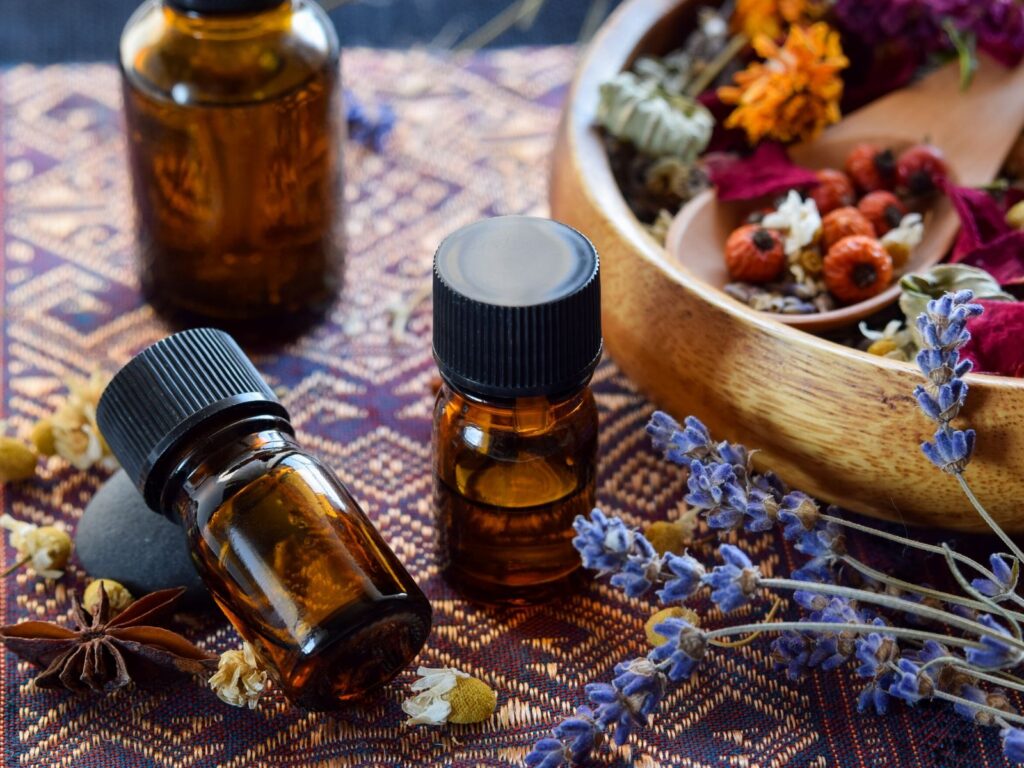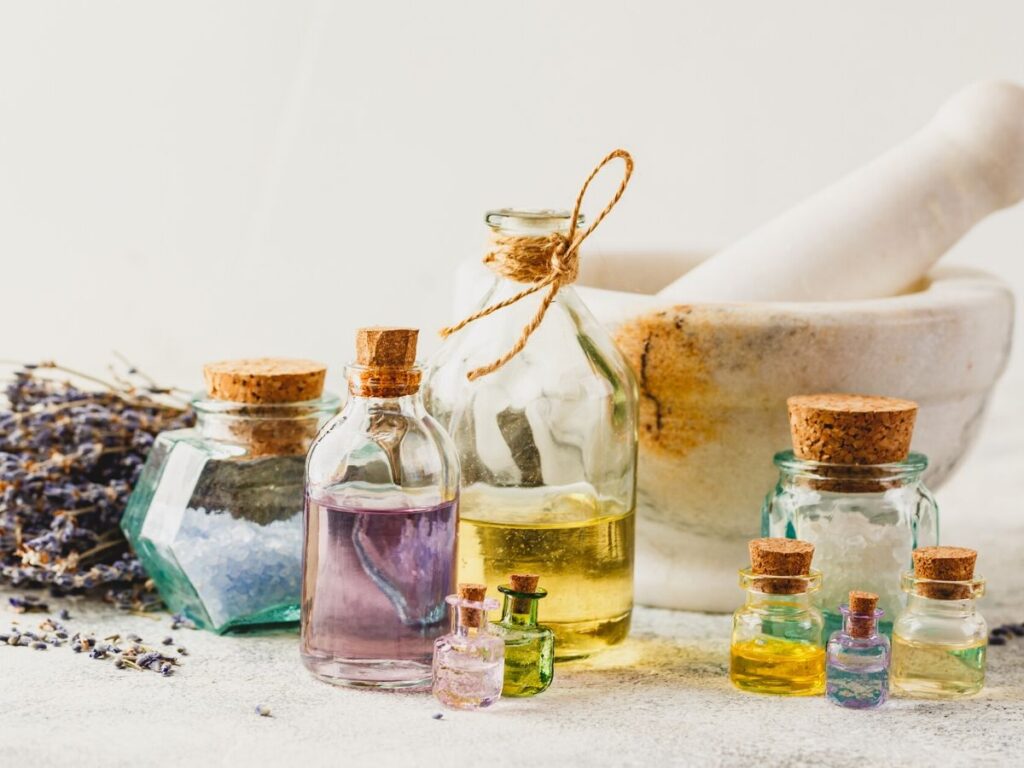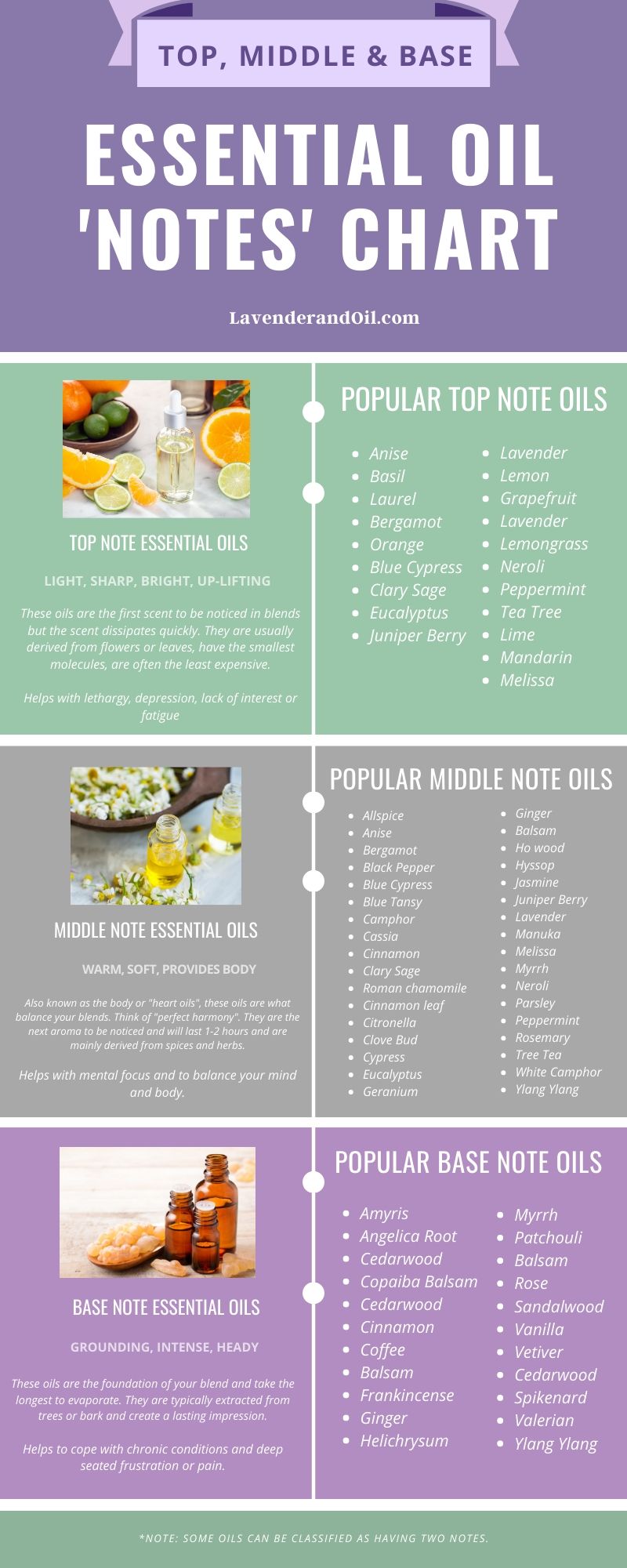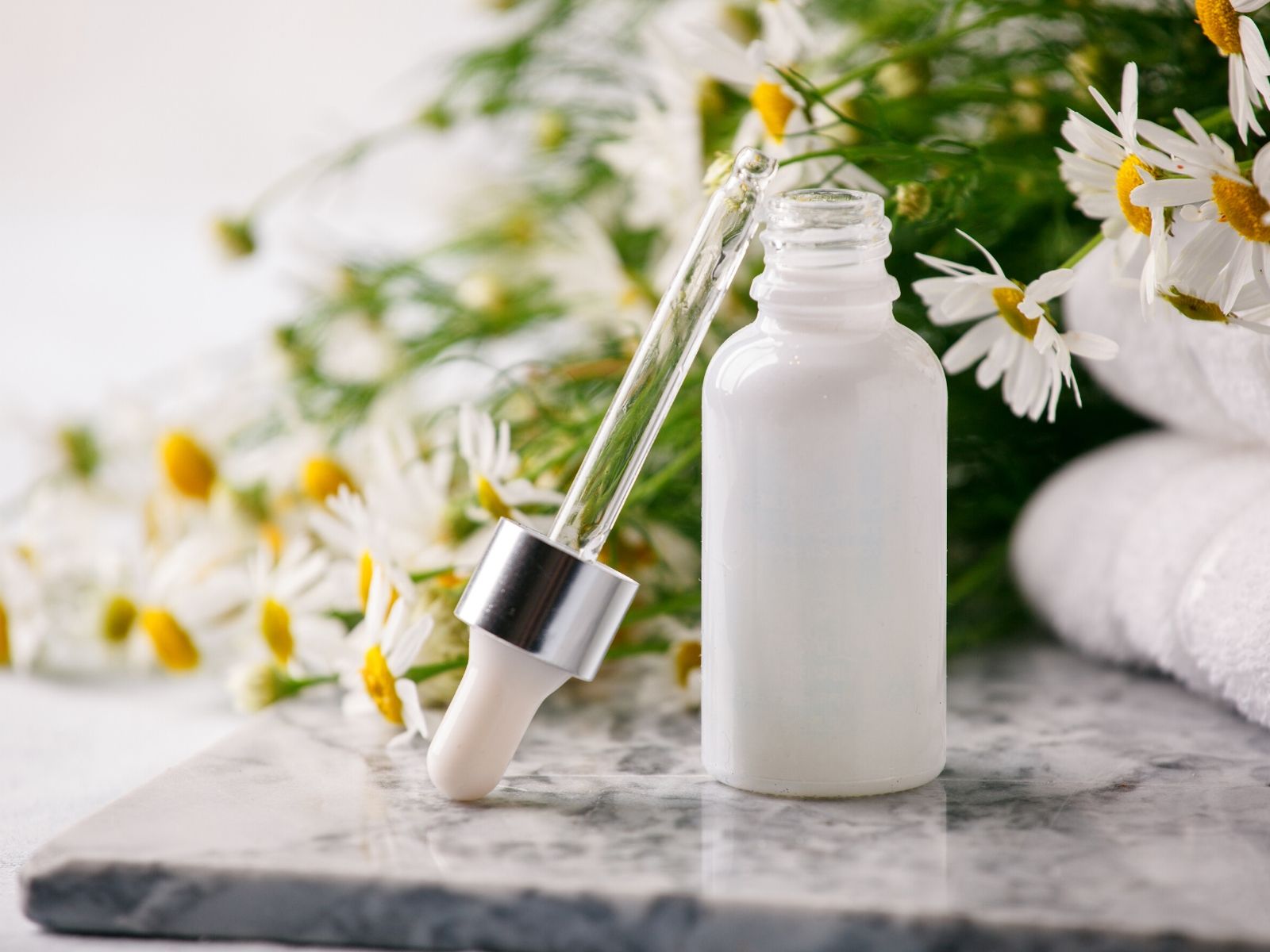Did you know that essential oils are categorized as having top, middle and base notes? Their note classification helps us understand how volatile each oil is so we can choose the right oils to create a blend that is harmonious, well balanced and lingers for hours (or even days)!

When I first started experimenting with creating my own unique essential oil blends, I realized that a lot did NOT work. They either did not smell good or I was not able to smell some of the oils I added. A TOTAL waste. And I hated wasting oils because they are not cheap.
Once I learned about the different oil notes, I was able to create my own DIY oil blends that worked SO well together with less wasted oils!
Get ready to put your limbic system to work!
How are essential oil “notes” useful?
A chemist named George William Septimus Piesse invented the concept of “notes” in perfumery which are stilled used today. Because essential oils are made up of numerous different compounds, they have different evaporation rates. This means that some oils will evaporate faster than others.
Why is this important?
Well if you want to create your own essential oil blends, you want to create one with the best “synergy” so that the fragrance lasts as long as possible. Otherwise you will be wasting your money.
I put together a list of the more popular essential oils below. They are each categorized alphabetically based on their note classification. Keep in mind that some of the oils below can be considered two notes.
💆♀️Check out these essential oils that will make your house smell like a spa!

Top Note Essential Oils List
Top note oils are the most “volatile” meaning they evaporate the quickest!
They also happen to have anti-viral properties. They are usually light aromas that are uplifting and are usually the least expensive.
- Anise
- Basil
- Balsam
- Bay Laurel
- Bergamot
- Cinnamon
- Clary Sage
- Coriander
- Eucalyptus
- Grapefruit
- Hyssop
- Lavender
- Lemon
- Lemongrass
- Lime
- Mandarin
- Neroli
- Niaouli
- Orange
- Peppermint
- Rosewood
- Sage
- Spearmint
- Tangerine
- Tea Tree
- Thyme
- Verbena
Middle Note Essential Oils (Body)
Middle note oils, also known as “heart notes”, are like the middle-man who helps the top oils and base oils come together nicely. They make up a majority of the oils. They last longer than top notes but not as long as base notes. They are typically extracted from spices and herbs.
Base Note Essential Oils (Fixative)
Base note oils create the full body of the fragrance. They are heavier oils which evaporate the slowest. They are usually more expensive and are extracted from trees, bark or roots. Base note oils are meant to ground you and provide a lasting impression.
- Balsam Peru
- Cassia
- Cedarwood
- Cinnamon
- Copaiba
- Frankincense
- Ginger
- Jasmine
- Myrrh
- Oakmoss
- Patchouli
- Peppermint
- Rose
- Rosewood
- Sandalwood
- Turmeric
- Valerian
- Vanilla
- Vetiver
- Ylang Ylang
Balancing your notes is key! Check out my recommended ratio below for how many drops to use of each note.
Did you know that essential oils have a shelf life? Make sure your oils have not expired!
Balancing And Blending Oil Notes PDF

If you are reading this because you want some help creating your own oil blends that “work”, here are some things to keep in mind before blending your oils:
- What is the note of each oil?
- What are the aroma profiles of each oil?
- What’s the purpose of each individual oil in your blend?
- What is the blend going to be used for?
- Will the oils will be exposed to sunlight?
- Does the oil contains esters?
A popular blending ratio is 3:5:2 which is 3 parts top note oils, 5 parts middle note oils and 2 parts base note oils.
How To Blend Notes
Blending does not need to be complicated. Just make sure not to overpower your blend! Since we all prefer different scents, there is no one scent that everyone will love. Mix and match until you get an aromatic blend that pleases your nose!
It is also recommended to use less top note/middle note oils than base note oils. Choosing a woody base note, a floral middle note and a citrusy top note will result in the most successful blends. Ideally you want to aim for 2 top note oils, 2 middle note oils and 1 base note oil. which is five total oils.
A popular blending ratio is 3:5:2 which is 3 parts top note oils, 5 parts middle note oils and 2 parts base note oils. You should not need more than six different essential oils in one blend. Sometimes just two oil blends are the best!
Some of the most popular top note oils:
Eucalyptus, lemon, peppermint, sweet orange, lavender, pink grapefruit, basil, bergamot, and clary sage.
Some of the more popular middle note oils are:
Roman chamomile, geranium, lavender and rosemary, black pepper, eucalyptus, rose absolute, ylang ylang, tea tree, clove, and cinnamon.
Popular base note oils are:
Cedarwood, jasmine, patchouli, myrrh, frankincense, vetiver, and vanilla oleoresin.
How To Start Blending
There is no right or wrong way to start testing different notes together. First determine what scents you already like. What candles have you purchased in the past that drew you in? Were they nature-inspired? Flowery? Crisp? Citrusy? Spicy? Start with those oils.
Then, add a few drops of a different note to the strip and inhale deeply. Add another drop of another note and repeat.
If you want a long-lasting oil blend, allow your strip to sit a while (15-60 minutes) before coming back to smell it. Does it still have an aroma or have all the oils evaporated off?
If you don’t smell much of a fragrance, maybe you add another oil that is longer- lasting.

Frequently Asked Questions
You need to be able to balance out the notes so that the aroma lasts as long as possible. A popular blending ratio is 3:5:2 which is 3 parts top note oils, 5 parts middle note oils and 2 parts base note oils.
The best way is subjective. Each person has different methods of using essential oils. The idea is to inhale them through your nose so they reach the olfactory nerve. Another way is to use a diffuser, you can also apply topically or (directly to your skin), or you can ingest them but this method has many skeptics because of safety concerns. Make sure to use a carrier oil too.
Final Notes on “Notes”
Don’t let this overwhelm or intimidate you! It is just a recommendation and should be simply looked at as a recipe guide. My suggestion is to start with a 1:1:1 ratio. Use a perfume testing strip or cotton ball to add your blend to it after you add each drop and take a whiff. Add more of what you think it needs. Have fun with your oils and don’t forget to write down everything! 🙂
What to read next!
Check out how to create the perfect roller ball blend!
Essential Oil Diffuser vs. humidifier
My favorite essential oil products and accessories

What about using a carrier oil to make it last longer or to make a bigger quantity?
Yes you can do that too especially if you are using the oil topically!
This is super helpful! I am leading a candle making class at the library and I have more knowledge about blending oil. Thanks!
Thank you Bree! I am glad it was helpful!
Thank you I really enjoyed reading this post 🙏🌸🌺🌼
you’re welcome!
This is so helpful, thank you! I see peppermint is listed under top, middle and base notes, why is this? Does it depend on the specific peppermint oil or can it be used as any note?
Is there a best way to infuse oils into fabrics in order to make them last for a long time?
Great question! Base note oils will last longer than others but it’s tough getting the smell to last a long time. If the fabric is not as exposed to air (like rolled up or folded or placed in an airtight container) that will help prolong the aroma.
Thank you for the information! I found it tremendously helpful as I’m playing around with oil blends. I think I may have found a typo – “It is also recommended to use less top note/middle note oils than base note oils.” – Was this supposed to say more rather than less? The ratios don’t make sense if you end up using more base notes than top/middle note oils. What am I missing?
Thanks great informative help for our new project. rgds Tom
Hi there,
Thanks for this helpful site you have put together. I do have a questions about the types of carrier oils. Does it matter what carrier oil we use? Does one carrier oil make a fragrance last longer than another carrier? Can I blend my carrier oil to get a different effect?
Cheers,
Kay
No it does not! 🙂 I like coconut and argan oil best. I have not noticed one working better than another.
Hello what is 3:5:2 ratio
Can you pls explain ?
Yes, 3 drops to 5 drops to 2 drops. So if you double the container, you double the ratios.
Excellent tips and web site. You are a very kind and giving person, we need more of that in the world today. Thank You as I construct my next cologne.
Hello, my favourite scents are citrus so i trued to make a perfume with Grapefruit, Lime and Lemon but the scent dosnt last. What would you recommend i add?
Thank you x
Hi! I’d try adding a base note like ylang ylang or ginger to help it last!
hi- can you explain the dilutions? is the 3:5:2 for a 10 ml rollerball dispenser? what percentage of concentration does this produce?
This ratio is for any size container. 3 parts to 5 parts to 2 parts. So that can be 3 drops, 5 drops, and 2 drops or 6 drops, 10 drops, 4 drops. It depends on how much oil you combine it with.
How to blend lavender as a top note and middle note? Is it by adding more drop of lavender then it became the middle note?
Hi, I’m trying to make perfume and I am trying to find top notes that go well with vanilla, jasmine, gardenia, lily of the valley, and Persian cyclamen. I’m using orange zest with gardenia and vanilla as one combo. But I’m struggling to pair non citrus scents with my florals. Do you want suggestions? Thanks😊
Hi, how would you blend say 2 or 3 notes from the same category list? Say lavender & mint? Is it equal amounts? Or say juniper berry, blackberry & rosemary? How do you know which is top, middle & base if the same category.
Wondering two things:
1. How is it that we are supposed to use more base notes than top notes, but the ratio is 3:5:2?
2. How is cinnamon a top note, middle note, and base note?
I am just starting to learn this stuff, and those are confusing to me.
Thanks!
Hello, I am trying to play around following your article, very helpful by the way!
I have a possibly silly question. I am trying to combine 5 fragrances, so I have 5 different strips. If after a 15/20 minutes I feel like adding an extra drop of one of those to enhance its smell, shall I use a new strip, or shall I just add another drop to the existing strip of that specific fragrance? Thanks
Good question. I would make a new strip with the additional drop since the point is to determine the overall aroma once everything sits together.